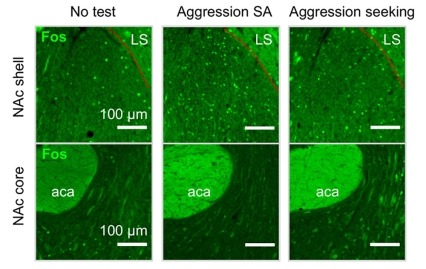Unlike drug addiction, aggressive behavior is an adaptive phenomenon that animals innately use for survival. However, aggression can also become pathological or maladaptive. Appetitive aggressive behavior in humans refers to positive feelings being associated with committing violent behavior. In nonhuman animals, it refers to violent actions that appear to satisfy a specific need, enough to be repeated. At its extreme, appetitive aggression can be highly rewarding and, like addictive drugs, nonhuman animals may pursue aggression despite the negative consequences associated with it.
In a rodent study published in The Journal of Neuroscience, scientists from NIDA’s Intramural Research Program show that neural mechanisms that control appetitive aggressive behavior are similar to those that control drug-taking and seeking (relapse), suggesting common neurobiological mechanisms of aggression reward and drug reward. In this study, Sam Golden (the Shaham lab) and IRP colleagues found that one group of nervous system cells, dopamine receptor 1-expressing neurons in nucleus accumbens, act as a critical modulator of appetitive aggressive behavior. This suggests that maladaptive aggression, observed in several neuropsychiatric disorders, could possibly be treated using approaches similar to those used to treat drug addiction.
Study:
- Golden, Sam A; Jin, Michelle; Heins, Conor; Venniro, Marco; Michaelides, Michael; Shaham, Yavin. Nucleus Accumbens Drd1-Expressing Neurons Control Aggression Self-Administration and Aggression Seeking in Mice. The Journal of Neuroscience.
